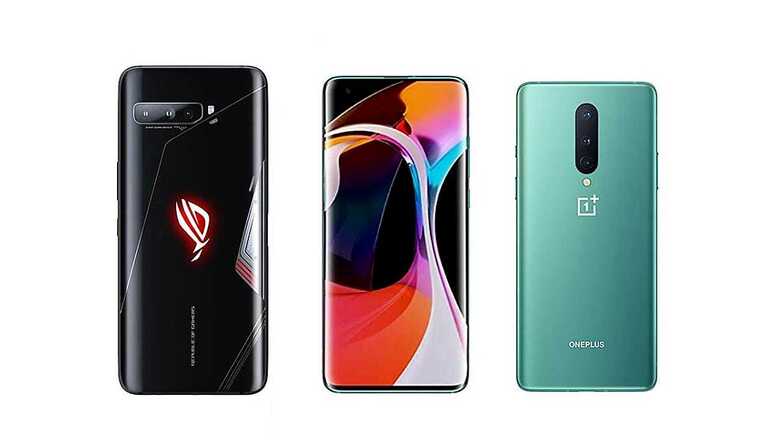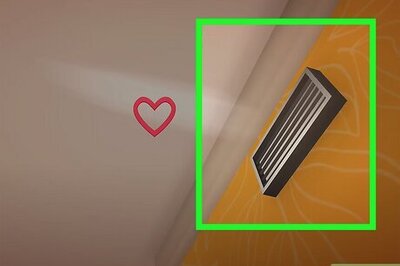
views
New smartphones continue to tread on populating markets despite the Covid-19 pandemic that swept across the world earlier this year. We’ve seen some impressive smartphones during the last few months especially in the affordable flagship segment from various brands. Qualcomm’s Snapdragon 865 chipset saw a wider adoption while Apple surprised us (kind of) with its new affordable iPhone SE.
We’ve listed some of the best phones that you can buy today in India, if you are looking for the best of the best experience under a budget of Rs 50,000.
Xiaomi Mi 10 5G
Xiaomi launched its most expensive smartphone in the Indian market, the Mi 10 5G. The handset also marked the return of the company’s flagship range to the country after it launched the Mi 5 back in 2016. The new Mi 10 5G is powered by the latest Snapdragon 865 chipset and supports 5G connectivity. It comes with a 6.67-inch 1080p AMOLED display with a refresh rate of 90Hz and 180Hz touch response rate. The company says it offers a peak brightness of 1,120 nits and offers 5,000,000:1 contrast ratio. It will be offered in two variants in India, 8GB RAM + 128GB storage and 8GB RAM + 256GB storage. Xiaomi is making use of LPDDR5 RAM and UFS 3.0 storage standard.
In terms of camera, the Mi 10 houses a 108-megapixel camera with a 1/1.33-inch sensor along with OIS (Optical Image Stabilisation), the second camera is a 13-megapixel ultra-wide camera with 123-degree FOV. The other cameras include a 2-megapixel macro sensor and a 2-megapixel depth sensor. The front camera of the device is 20-megapixels and is placed in the punch-hole cutout.
The battery is rated at 4,780mAh along with support for 30W fast wired and wireless charging. There is also support for 10W reverse charging that is Qi-compatible. The brand has further included Wi-Fi 6 to make for overall faster download and upload speeds via Wi-Fi networks. It runs on the latest MIUI 11 based on Android 10. Both variants will be available in Coral Green and Twilight Grey colour options.
Additionally, the company also offers the Mi 30W Wireless Charger based on Qi standard. The charger is an add-on accessory for the Mi 10 and comes with a built-in cooling fan. It is priced at Rs 2,299.
In our testing we found the Mi 10 5G to be one of the most feature rich smartphone in its category having an impressive camera, the option of fast wired and wireless charging, a premium design and of course, excellent performance. The Mi 10 launched at Rs 49,999 but the company is expected to introduce a price cut considering the fact that it sold the the phone for Rs 42,999 for a short period of time during the Amazon Prime Day sale.
ASUS ROG Phone 3
Mobile phone gamers, look no further. ASUS introduced its new ROG Phone 3 this year that basically rides on the success of the ROG Phone 2 from last year. The new smartphone continues to sport a 6.59-inch AMOLED 2340x1080 full-HD+ display. But this time the company has upgraded the refresh rate to 144Hz along with a 270Hz touch sampling rate and 25ms touch latency. It is also HDR10+ certified with a claimed 1000nits peak brightness, 113% DCI-P3 Delta E average <1%, TÜV Low Blue Light, Flicker Reduced certifications and finally a 2.5D Gorilla 6 Glass.
It is powered by the newest Qualcomm Snapdragon 865+ chipset, making it the first phone in India to bring the latest flagship processor. According to the company it can be pushed up to speeds of up to 3.1GHz. There is the option of either 8GB of LPDDR5 RAM with 128GB UFS 3.1 storage or 12GB of LPDDR5 RAM with 256GB of UFS 3.1 storage.
The camera department also sees an update with the primary setup including 64-megapixel f/1.8 camera, a 13-megapixel, f/2.4 ultrawide camera and a 5-megapixel f/2.0 macro camera. This offers PDAF, EIS and the ability to shoot 8K videos at 30fps. The front camera is a 24-megapixel f/2.0 camera to take selfies.
The phone continues to offer a large 6,000mAh battery which is excellent since you need a lot of juice while gaming. It supports 30W fast charging and ASUS is bundling a fast charger in the box. The battery can also reverse charge at 10W.
It is a 5G capable phone making it future proof, along with support for dual-SIM. Some of the neat features from the ROG Phone 2 make a comeback including the front facing dual-stereo DTS:X speakers with dedicated amplifiers. The extra USB-C port on the side is also there, so you can charge and play without any wires getting in the way. Notably, the headphone jack has been removed, but the company provides a USB Type-C to 3.5mm jack converter in the box. The shoulder buttons or the new AirTrigger 3 system expands upon the existing ultrasonic sensors with an additional motion sensing input. In addition to the tap and slide functions the Ultrasonic buttons now also support swiping and dual partition button.
Lastly you get an in-display fingerprint scanner, face unlock, and Android 10 OS with ROG UI or the option of a more clean stock android interface. It might not be a huge upgrade from the ROG Phone 2, but it is definitely the most powerful Android smartphone on the market today. At Rs 49,999 the ROG Phone 3 is a highly recommended option for a power-user and of course mobile gamers. Notably, it is currently in limited stocks so it could be difficult to grab one.
OnePlus 8
OnePlus graduated to a more premium smartphone offering this year with the new OnePlus 8 series. Apart from the Pro version, which is now the current flagship, the OnePlus 8 is one of the best all-rounder smartphones under the Rs 50,000 price range. It features a 6.55-inch Full-HD+ (1080 x 2400 pixels) Fluid AMOLED display that comes with a 90Hz refresh rate. The smartphone is powered by the Qualcomm Snapdragon 865 chipset, paired with up to 12GB of LPDDR4X RAM while storage options include 128GB and 256GB. As for the cameras, there is a 48-megapixel Sony IMX586 sensor along with a 16-megapixel sensor with an ultrawide lens, and a 2-megapixel macro camera. The front camera is a 16-megapixel sensor with fixed focus.
Rest of the features include an in-display fingerprint sensor, 5G, 4G LTE, Wi-Fi 6, Bluetooth v5.1, GPS/ A-GPS, NFC, and a USB Type-C port. The battery is rated at 4,300mAh with Warp Charge 30T (5V/ 6A) support.
The OnePlus 8 in our opinion is a complete fuss free device that offers a great balance of performance, all-day battery, clean software and great looks. Priced at Rs 41,999 for the 6GB + 128GB storage configuration which is selling exclusively on Amazon India. The 8GB + 128GB variant is priced at Rs 44,999 and the 12GB + 256GB storage variant is priced at Rs 49,999.
Apple iPhone SE
Apple launched a sequel to it's tiny and affordable iPhone by just slapping a new chipset on the iPhone 8. By doing so, it not only brought new life to the dated smartphone, but now it had a new offering at a much affordable price point. The new Apple iPhone SE comes with a 4.7-inch Retina HD display and remains one of the rare compact smartphones in this day and age. This display also takes advantage of features such as True Tone which adjusts the display according to the ambient lighting, as well as Dolby Vision and HDR10 compatibility. This runs on the Apple A13 Bionic chip, which also powers the Apple iPhone 11 line-up. The A13 Bionic has a dedicated 8-core Neural Engine capable of 5 trillion operations per second, two Machine Learning Accelerators on the CPU and a new Machine Learning Controller. The battery is rated the same as the iPhone 8 at 1,810mAh. There is also wireless charging onboard along with standard 18W wired charging. Notably, the iPhone SE will be getting the all-new iOS 14 update later this year.
Launched at a starting price of Rs 42,500 the iPhone SE for Rs 35,999 on Flipkart. The SE is perfect for someone who cares for a smaller, more manageable handset or someone who wants to invest in their first ever iPhone.
iQOO 3
Vivo’s sub-brand made its entry into India earlier this year with its first smartphone, the iQOO 3. During its time, it was the first phone to launch with Qualcomm’s new flagship chipset, the Snapdragon 865. It is still the most affordable smartphone on the market rocking that chipset.
The iQoo 3 features a 6.44-inch Full-HD+ (1080 x 2400 pixels) Super AMOLED display with support for HDR 10+ and 91.40 percent screen-to-body ratio with Schott Xensation UP protective layer. There is a punch-hole on the top right corner for the camera and other features include a 180Hz touch sampling rate, and 800 nits of peak brightness that can max out at 1200 nits in certain cases. as per iQoo.
As mentioned above, the handset is powered by the Qualcomm Snapdragon 865 SoC paired with up to 12GB of LPDDR5 RAM and 256GB of UFS 3.1 storage. There is a quad-camera setup at the back with a 48-megapixel primary camera with the Sony IMX582 sensor and an f/1.79 aperture lens. This is paired to a 13-megapixel telephoto lens with an f/2.46 aperture and 20x digital zoom, a 13-megapixel wide-angle snapper with an f/2.2 aperture and a 120-degree field of view, and a 2-megapixel portrait camera with an f/2.4 aperture. At the front, there is a 16-megapixel selfie camera with an f/2.45 aperture.
Rest of the features include 5G, 4G, Bluetooth 5.1, dual-SIM card tray, USB Type-C 2.0, GPS, Glonass and a 4,440mAh battery. The large battery can be charged from 0-50% in just 15 mins using the proprietary 55W Super FlashCharge technology. The handset will be offered in Quantum Silver, Tornado Black and Volcano Orange colour options.
The handset is currently selling at Rs 34,990 for the base variant offering 8GB of RAM and 128GB of storage. The 8GB + 256GB variant is priced at Rs 37,990 while the top of the line 12GB + 256GB variant will be available for Rs 44,990. Notably, iQoo is offering 5G connectivity only on the top variant, although that seems irrelevant for the Indian market.

















Comments
0 comment